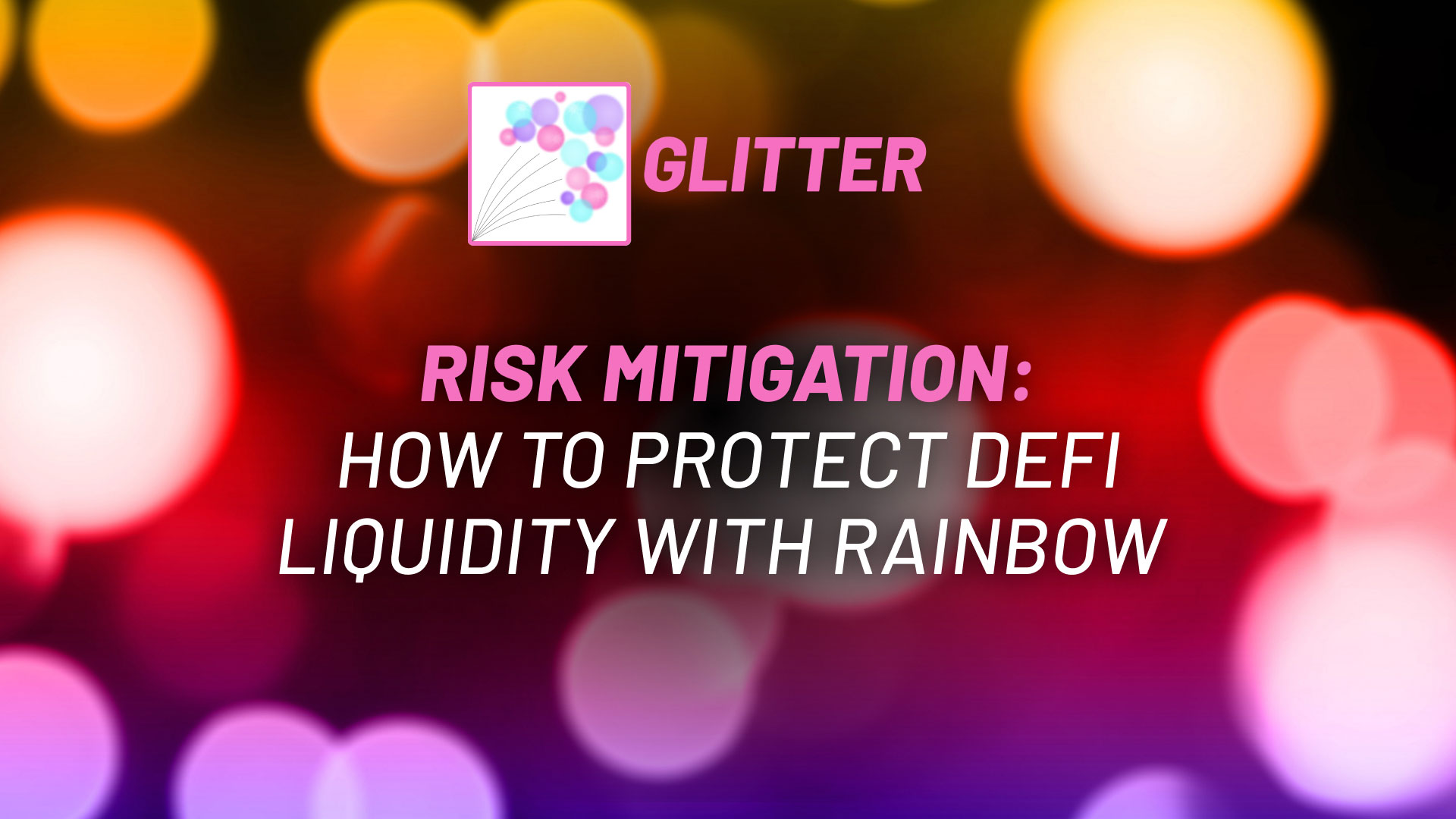Risk Mitigation: How to Protect DeFi Liquidity with Rainbow
Nov 18, 2022

There's no doubt that Decentralized Finance, or DeFi, is here to stay. The promise of permissionless financial services that are open and accessible to anyone, anywhere, has captured the world's attention. A fundamental change in the way people access finance is underway.
According to tracker DeFi Pulse, the Total Value Locked (TVL) in DeFi peaked at nearly $100 billion in late 2021. But the DeFi money printer doesn't always go brrrr---like all financial services, there are risks involved, and any good DeFi strategy requires serious consideration of risk mitigation strategies. Fortunately, there are services out there helping everyday users reduce the risks that come with DeFi investing.
Rainbow Network is one such service. Rainbow is an entire blockchain ecosystem built to help DeFi investors access siloed liquidity and mitigate risk. A user-friendly mobile layer means that anyone---even investors with no prior blockchain experience---can access the incredible opportunities within DeFi.
How does Rainbow Network improve access to liquidity and provide investors with risk mitigation opportunities? Read on to find out more.
Improved access to fragmented liquidity sources
There's a lot of money in blockchains, but these blockchains are isolated from one another. Money invested into the Solana ecosystem, for example, is stuck on Solana until it is removed from the ecosystem entirely to be moved somewhere else. Someone using the Algorand blockchain cannot access the liquidity or value on Solana without using a 'bridge' like Glitter.
Rainbow Network recognizes this growing problem and offers a solution through which any blockchain---and the money and data on it---can seamlessly interact with any other blockchain. This solution is known as interoperability, a theory core to the network design of Rainbow.
Built on top of an interoperable layer-0, Rainbow connects isolated blockchains, unlocking otherwise siloed liquidity and improving DeFi access.
For anyone with DeFi liquidity stuck on a particular chain, this is exciting news. With Rainbow Network, DeFi DApps can access liquidity on any supported blockchain, increasing fee revenues for stakers by connecting you with the busiest DeFi ecosystems, no matter which chain you provide liquidity for.
To learn more about how Rainbow Network connects DeFi liquidity between blockchains, read our whitepaper.
Single-token staking protects against impermanent loss
Impermanent loss is a risk that DeFi liquidity providers must contend with. Impermanent loss occurs when the value of one asset in an asset pair changes against the other. To explain it better, let's look at an example.
Let's say that Bob wants to add liquidity to the ETH/USDT pair on a Decentralized Exchange (DEX). To do this, Bob must add Ethereum and USDT tokens in an equal ratio---that is, for every $1 of USDT, he must add $1 of Ethereum. For this example, let's say that 1 ETH is worth $1,000.
Bob wants to add 1 ETH in liquidity to the pool. If ETH is worth $1,000, that means he needs to add 1,000 USDT as well. He does so and begins earning DeFi rewards from the liquidity he added.
A little while later, Bob wants to withdraw his liquidity. However, in this time the price of ETH has risen to $2,000. When he goes to withdraw, Bob receives his 1,000 USDT back, but only 0.5 ETH. This is because $1,000 only gets you 0.5 ETH instead of 1 ETH. This is known as impermanent loss.
It's difficult to create risk mitigation strategies against impermanent loss. The dollar value of your withdrawal might be the same, but the number of tokens changes. One option is to avoid adding liquidity to DeFi pools, however, that also means missing out on the rewards.
Rainbow Network reduces the risk of impermanent loss through single-asset staking pools. When you add single-asset liquidity, there is no risk of impermanent loss as there is no other asset to be pegged to. When you add 1 ETH of liquidity, you can always withdraw 1 ETH at any time.
Single-token staking is a good way for investors to begin exploring DeFi without the risk of impermanent loss. While no investment is riskless, single-asset staking is a good way to earn rewards while also practicing risk mitigation in your portfolio.
Token baskets mitigate risk by spreading it across multiple assets
Token baskets are another way to mitigate risk in DeFi, although by taking the opposite approach to single-asset staking. Rather than creating liquidity pools with one or even two assets, token baskets contain three or more assets in varying ratios. One famous example of a token basket is Curve Finance's 3pool---a token basket containing three major stablecoins.
Just as with two-asset pools, token baskets require users to deposit liquidity in certain ratios. When you go to withdraw your tokens, there is a risk that you could be hit by impermanent loss. However, as there are more assets in the basket, the risk is mitigated across the entire pool. A loss that could come from one token could be offset by a gain in another.
Rainbow Network is launching token baskets to support liquidity transfers across supported blockchains via the layer-0 Glitter Bridge. These baskets incentivize liquidity providers to make their assets available to DeFi users by offering a way to earn through DeFi that is risk mitigated.
Whether you're looking to leverage DeFi as a trader or want to make the most out of your liquidity, Rainbow Network offers the best DeFi solutions for anyone with risk mitigation on their mind.
About Rainbow Network
Scalability, interoperability, and ease of use are what every blockchain aspires to offer, yet few---if any---have achieved this. At Rainbow Network, we have, and in a very unique way.
Through the Glitter Bridge---a bridge that drives the unparalleled interoperability of Rainbow Network and allows for seamless connectivity between chains--- Rainbow offers DApp developers a blockchain that does away with the headaches of deciding where to base their project. By building on Rainbow Network, a project launching a DeFi DApp can instantly achieve multichain status, enabling them to deploy their token and application to a growing list of supported chains including Ethereum, Cosmos, Solana, and Algorand.
Beyond just interoperability, this cross-connectivity opens the floodgates to a wave of new liquidity from each ecosystem's user base. In addition, running on multiple chains innately offers multichain redundancy and increased security: if a hack or network outage occurs on one chain, a project on Rainbow Network can continue to operate with zero downtime on the other chains it's connected with.
Rainbow Network isn't just for builders---it's for everyone. We understand that the future of blockchains comes from mass adoption, which is why we've developed a native mobile application that will allow users of all experience levels to tap into the power and benefits the blockchain has to offer through a sleek, simple user interface.
The future of the blockchain is multichain, and the future of multichain is Rainbow Network.
Rainbow Network: Everyone's Welcome 🌈
Learn more at (https://www.rainbownetwork.io)[https://www.rainbownetwork.io]



